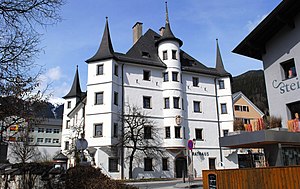Rosenberg Castle
| Rosenberg | ||
|---|---|---|
|
East facade |
||
| Creation time : | Baroque (end of the 16th century) | |
| Castle type : | City Palace | |
| Conservation status: | used ( town hall ) | |
| Standing position : | civil ( trade headquarters ) | |
| Place: | Zell am See | |
| Geographical location | 47 ° 19 '24 " N , 12 ° 47' 47.2" E | |
| Height: | 760 m above sea level A. | |
|
|
||
Rosenberg Castle is a castle in the center of the city of Zell am See . It has been the seat of the mayor and the city administration of Zell am See since 1970 and is located directly on the Brucker Bundesstrasse . The castle garden, the castle park and the Rathausparkgarage are also in the immediate vicinity.
architecture
The architecture corresponds to that of a typical Salzburg residence : the four-storey building is almost square in its area and has a corner bay at each of the four corners and a semicircular central bay at the east-facing main facade. It is covered by a mighty hipped roof.
history
Rosenberg Castle was built at the end of the 16th century by the two trades brothers Karl and Hans Rosenberger zu Rosenegg on a plot of land that had previously been used for agriculture (Weinlehen) . This is now in the center of the city of Zell am See. The two builders had bought the property on February 14, 1577 from the citizen of Zell Balthasar Egger and his housewife Regina Stainerin.
After Hans Rosenberger died in 1604, the castle passed to his three sons Hans, Georg and Hans Christoph. When Georg died in 1614 and Hans sold his share to Hans Christoph in 1633 because of large debts, the latter became the sole owner. He sold the castle to Baron Karl Khuen in 1640. After his death, his son Wolf Wilhelm Khuen could not take over the inheritance due to illness, which is why it passed to the family members and brothers Hans Sigmund and Erasmus Khuen von Belasy in 1662. After her death, the commissioned curators sold it to Baron Georg Dietrich Khuen zu Kammer in 1670. His daughters handed the castle over to Maximilian Johann Preisgott Count Khuen zu Kammer und Prielau in 1706, who sold it to Joseph Anton Jud, a landlord from Piesendorf , in 1716 .
This was followed by major renovations, but also the partial neglect of the castle before it was sold on to Johann Michael Silberer in 1762 by Wolfgang Sigmund Jud, son of the previous owner. This was a beer brewer and set up a restaurant in the castle. But already in 1769 the property was sold again, this time to a mining college from Salzburg, which housed their administrators in the castle. Franz von Lürzer followed as the last private owner in 1820.
In 1842, the Imperial and Royal Forestry Office was housed in Rosenberg, which until then had been housed in Fischhorn Castle. From 1867 it then belonged to the imperial-royal court , and the Zell am See district court was housed in it until 1903. From 1928 Rosenberg Castle belonged to the Republic of Austria. From 1941 to 1945 it was taken over by the German Reich and then (from 1947) it served as the administrative seat of the Austrian Federal Forests .
In 1970 the municipality of Zell am See finally acquired the castle and converted it into the town hall in the course of gentle construction measures . It still fulfills this function today. The building was last modernized between June and December 2009 for around 800,000 euros.
literature
- Friederike Zaisberger , Walter Schlegel : Castles and palaces in Salzburg - Pongau, Pinzgau, Lungau , Birken-Verlag Vienna, 1978, ISBN 3-85030-037-4 , p. OA
Web links
- Entry via Rosenberg Castle to Burgen-Austria
Individual evidence
- ↑ The Zell am See town hall shines in a completely new light. In: Pinzgauer Bezirksblätter No. 3, January 20, 2009



